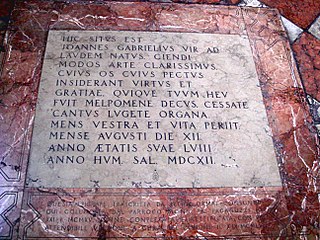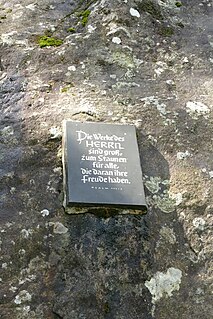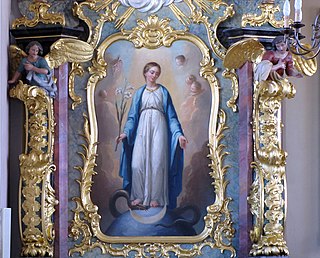Related Research Articles

In Western classical music, a motet is mainly a vocal musical composition, of highly diverse form and style, from the high medieval music to the present. The motet was one of the pre-eminent polyphonic forms of Renaissance music. According to Margaret Bent, "a piece of music in several parts with words" is as precise a definition of the motet as will serve from the 13th to the late 16th century and beyond. The late 13th-century theorist Johannes de Grocheo believed that the motet was "not to be celebrated in the presence of common people, because they do not notice its subtlety, nor are they delighted in hearing it, but in the presence of the educated and of those who are seeking out subtleties in the arts".

Josquin des Prez was a French composer of high Renaissance music. The central figure of the Franco-Flemish School, Josquin is widely considered the first master of the complex Renaissance style of polyphonic which emerged during his lifetime. His career spanned France and Italy under the patronage of the House of Sforza, two popes, Louis XII and Ercole I d'Este among others, yet the details of his activity is shadowy, and almost nothing is known about his personality. More than 370 works are attributed to him; it was only after the advent of modern analytical scholarship that some of these attributions were challenged and revealed as mistaken, on the basis of stylistic features and manuscript evidence. Regardless, he was among the most innovative and well-known composers of his time, exerting a profound influence on both his contemporaries and subsequent composers.

Giovanni Gabrieli was an Italian composer and organist. He was one of the most influential musicians of his time, and represents the culmination of the style of the Venetian School, at the time of the shift from Renaissance to Baroque idioms.
Pierre de Manchicourt was a Renaissance composer of the Franco-Flemish School.

Michel Richard Delalande [de Lalande] was a French Baroque composer and organist who was in the service of King Louis XIV. He was one of the most important composers of grands motets. He also wrote orchestral suites known as Simphonies pour les Soupers du Roy and ballets.
Melchior Franck was a German composer of the late Renaissance and early Baroque eras. He was a hugely prolific composer of Protestant church music, especially motets, and assisted in bringing the stylistic innovations of the Venetian School north across the Alps into Germany.

Louis-Nicolas Clérambault was a French musician, best known as an organist and composer. He was born, and died, in Paris.

Jesu, meine Freude, BWV 227, is a motet by Johann Sebastian Bach. The longest and most musically complex of his motets, it is set in eleven movements for up to five voices. It is named after the Lutheran hymn "Jesu, meine Freude" with poetry by Johann Franck, first published in 1653. The motet contains the six hymn stanzas in its odd-numbered movements. The hymn tune by Johann Crüger appears in all these movements, in different styles of chorale setting. The text of the motet's even-numbered movements is taken from the Epistle to the Romans, a passage which influenced key Lutheran teachings. The hymn, written in the first person with a focus on an emotional bond to Jesus, forms a contrasting expansion of the doctrinal scripture text. Bach set both texts alternating, complementing each other, in a structure of symmetries on different layers.

Psalm 111 is the 111th psalm of the biblical Book of Psalms. In the slightly different numbering system in the Greek Septuagint version of the bible, and in its Latin translation, the Vulgate, this psalm is Psalm 110. Psalms 111, 112 and 119 are the only psalms which are acrostic by phrase in the Bible; that is, each 7-9 syllable phrase begins with each letter of the Hebrew alphabet in order.
The grand motet was a genre of motet cultivated at the height of the French baroque, although the term dates from later French usage. At the time, due to the stylistic feature of employing two alternating choirs, the works were typically described as motet pour deux choeurs - motet for double choir.
O Jesu Christ, meins Lebens Licht, BWV 118, is a sacred motet composed by Johann Sebastian Bach. It is known to have been performed at a funeral, and was possibly a generic work intended for funerals. When the work was first published in the nineteenth century it was called a cantata, perhaps because it has an instrumental accompaniment. While it is not an a cappella work, modern scholarship accepts it is a motet.

Virga Jesse, WAB 52, is a motet by the Austrian composer Anton Bruckner. It sets the gradual Virga Jesse floruit for unaccompanied mixed choir.

Vexilla regis, WAB 51, is the final motet written by the Austrian composer Anton Bruckner.

Locus iste, WAB 23, is a sacred motet composed by Anton Bruckner in 1869. The text is the Latin gradual Locus iste for the annual celebration of a church's dedication. The incipit, Locus iste a Deo factus est, translates to "This place was made by God". Bruckner set it for four unaccompanied voices, intended for the dedication of the Votivkapelle at the New Cathedral in Linz, Austria, where Bruckner had been a cathedral organist. It was the first motet that Bruckner composed in Vienna. It was published in 1886, together with three other gradual motets.

Christus factus est, WAB 11, is a sacred motet by Anton Bruckner, his third setting of the Latin gradual Christus factus est, composed in 1884. Before, Bruckner composed in 1844 a first piece on the same text as gradual of the Messe für den Gründonnerstag, and in 1873 a motet for eight-part mixed choir, three trombones, and string instruments ad libitum. The motet is an expressive setting of the gradual, influenced by Wagner's music.

Os justi, WAB 30, is a sacred motet composed by Anton Bruckner in 1879. Os Justi is a Gregorian chant used as gradual of the Commune Doctorum, and as introit I and gradual II of the Commune Confessoris non Pontificis.

Veni Creator Spiritus, WAB 50, is a motet composed by Anton Bruckner in c. 1884.

Iam lucis orto sidere, WAB 18, is a motet composed by Anton Bruckner in 1868. The work is also known as In S. Angelum custodem. Bruckner revised the composition in 1886.
Quatre motets pour un temps de pénitence, FP 97, are four sacred motets composed by Francis Poulenc in 1938–39. He wrote them on Latin texts for penitence, scored for four unaccompanied voices.
References
- ↑ London, Royal College of Music, MS 1070.